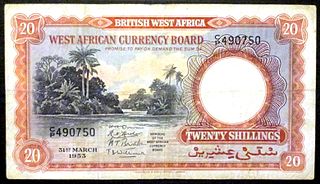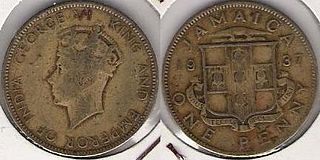
Pound is the name of various units of currency. It is used in some countries today and previously was used in many others. The English word "pound" derives from the Latin expression lībra pondō, in which lībra is a noun meaning 'pound' and pondō is an adverb meaning 'by weight'. The currency's symbol is '£', a stylised form of the blackletter 'L', crossed to indicate abbreviation.
The British West Indies dollar (BWI$) was the currency of British Guiana and the Eastern Caribbean territories of the British West Indies from 1949 to 1965, when it was largely replaced by the East Caribbean dollar, and was one of the currencies used in Jamaica from 1954 to 1964. The monetary policy of the currency was overseen by the British Caribbean Currency Board (BCCB). It was the official currency used by the West Indies Federation The British West Indies dollar was never used in British Honduras, the Cayman Islands, the Turks and Caicos Islands, the Bahamas, or Bermuda.

The pound was the currency of British West Africa, a group of British colonies, protectorates and mandate territories. It was equal to one pound sterling and was similarly subdivided into 20 shillings, each of 12 pence.
In 1820, in response to a request from the British colony of Mauritius, the imperial government in London struck silver coins in the denominations of 1⁄4, 1⁄8, and 1⁄16 dollars. The dollar unit in question was equivalent to the Spanish dollar and these fractional coins were known as 'Anchor Dollars' because of the anchor that appeared on them. More of these anchor dollars were struck in 1822 and not only for Mauritius but also for the British West Indies. In addition to this, a 1⁄2 dollar anchor coin was struck for Mauritius. A year or two later, copper dollar fractions were struck for Mauritius, the British West Indies, and Sierra Leone.
The pound was the currency of Nigeria between 1907 and 1973. Until 1958, Nigeria used the British West African pound, after which it issued its own currency. The pound was subdivided into 20 shillings, each of 12 pence. The Nigerian pound - at parity with sterling with free convertibility - was replaced in 1973 with the decimal naira at a rate of £1 = ₦2., rendering Nigeria the last country to abandon the pre-decimal £sd currency system.

The pound was the currency of the Union of South Africa from the formation of the country as a British Dominion in 1910. It was replaced by the rand in 1961 when South Africa decimalised.
The pound was the currency of Tonga until 1967. It was subdivided into 20 shillings, each of 12 pence.

The pound was the official currency of Jamaica between 1840 and 1969. It circulated as a mixture of sterling coinage and locally issued coins and banknotes and was always equal to the pound sterling. The Jamaican pound was also used in the Cayman and Turks and Caicos Islands.
The pound was the currency of the Bahamas until 1966. It was equivalent to the pound sterling and was divided into 20 shillings, each of 12 pence. Standard sterling coinage circulated. Apart from a Bahamas penny coin struck in 1806, there were no special coin issues such as were found in Jamaica.
The Mark was the currency of German South West Africa between 1885 and 1915. Until 1914, the German Mark circulated. Within days of the outbreak of the First World War, an issue of paper money titled Deutsch-Südwestafrikanische Mark was authorized in denominations of 5, 10, 20, 50 and 100 Marks.
The history of currency in the British colony of Dominica closely follows that of the British Eastern Caribbean territories in general. Even though Queen Anne's proclamation of 1704 brought the gold standard to the West Indies, silver pieces of eight continued to form a major portion of the circulating currency right into the latter half of the nineteenth century.
The history of currency in the British colony of Grenada closely follows that of the British Eastern Caribbean territories in general. Even though Queen Anne's proclamation of 1704 brought the gold standard to the West Indies, silver pieces of eight continued to form a major portion of the circulating currency right into the latter half of the nineteenth century.
The history of currency in the British colony of St. Kitts closely follows that of the British Eastern Caribbean territories in general. Even though Queen Anne's proclamation of 1704 brought the gold standard to the West Indies, silver pieces of eight continued to form a major portion of the circulating currency right into the latter half of the nineteenth century.
The dollar was the currency of Nevis until 1830. The currency consisted of counterstamped Spanish and French colonial coins. The dollar was subdivided into 72 black dogs, each of 1½ pence. Around 1801, coins were issued for 1, 4, 6, 7 and 9 black dogs with the word "Nevis" and the denomination stamped on them. The 1 black dog coins were countermarked on French Guianan 2 sous, whilst the 9 black dogs were made from Spanish colonial 1 real coins. In 1830, sterling was established as the official currency of the island.
The livre was the currency of Saint Lucia until 1814. The Saint Lucia livre was a French colonial currency, distinguished by the use of various cut Spanish and Spanish colonial coins. The livre was subdivided into 20 sous, each of 12 deniers. The escalin was worth 15 sous, with the stampee worth 3 sous 9 denier. Until 1813, 12 escalins were equal to 8 reales, after which 15 escalins equaled 8 reales. In 1851, sterling was introduced for circulation.
The history of currency in the British colony of Saint Vincent closely follows that of the British Eastern Caribbean territories in general. As such, it should not be considered in isolation. In order to get a broad overview of currency in the region, see the article British West Indies dollar.
The dollar was the currency of Trinidad until 1814. The currency comprised various cut Spanish dollars and other Spanish colonial coins. Before 1811, the dollar was worth 8 shillings, each of 12 pence. After 1811, it was worth 9 shillings. In 1814, sterling was established as the official currency of the island. Since 1905, dollars have once more circulated on Trinidad, first the Trinidad and Tobago dollar, then the British West Indies dollar, before the Trinidad and Tobago dollar was reintroduced.
The dollar was the currency of Tobago until 1814. The currency comprised various cut Spanish dollars and countermarked French colonial coins. The dollar was subdivided into 11 bits, each of nine pence. In 1814, sterling was established as the official currency of the island. Since 1905, dollars have once more circulated on Tobago, first the Trinidad and Tobago dollar, then the British West Indies dollar, before the Trinidad and Tobago dollar was reintroduced.
Antigua and Barbuda are two separate islands which operate as one country. Along with many other countries of the Caribbean, they use the East Caribbean dollar as their official currency, which was first brought into circulation in 1965 to replace the British West Indies dollar.
The history of currency in the British colony of Saint Lucia closely follows that of the British Eastern Caribbean territories in general. Even though Queen Anne's proclamation of 1704 brought the gold standard to the West Indies, silver pieces of eight continued to form a major portion of the circulating currency right into the latter half of the nineteenth century.



